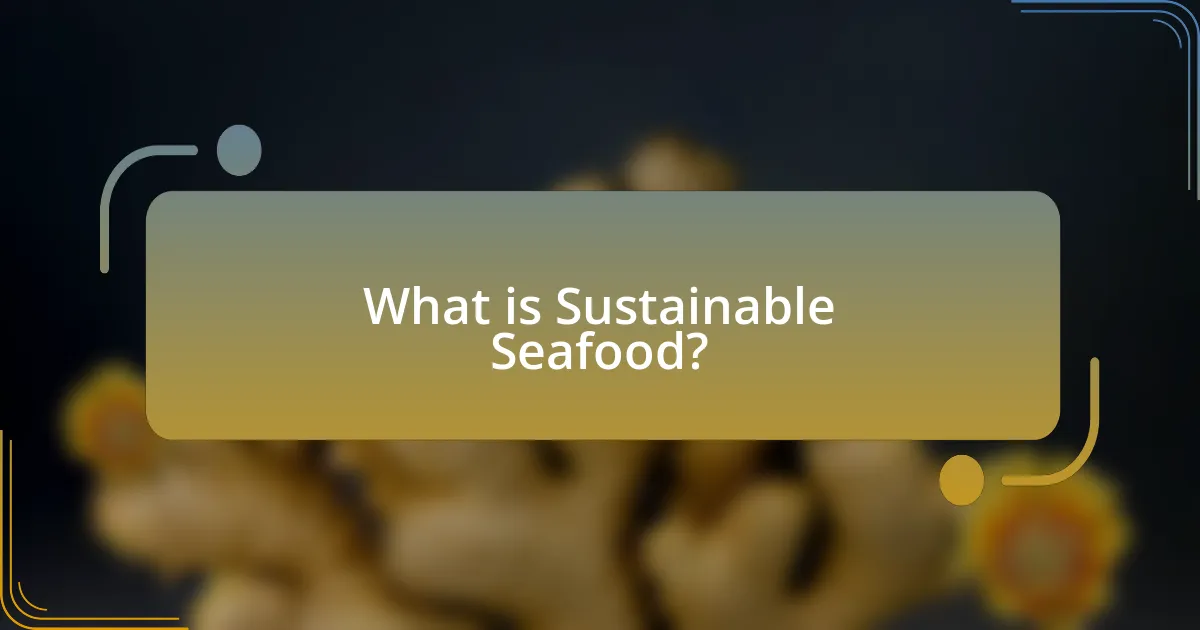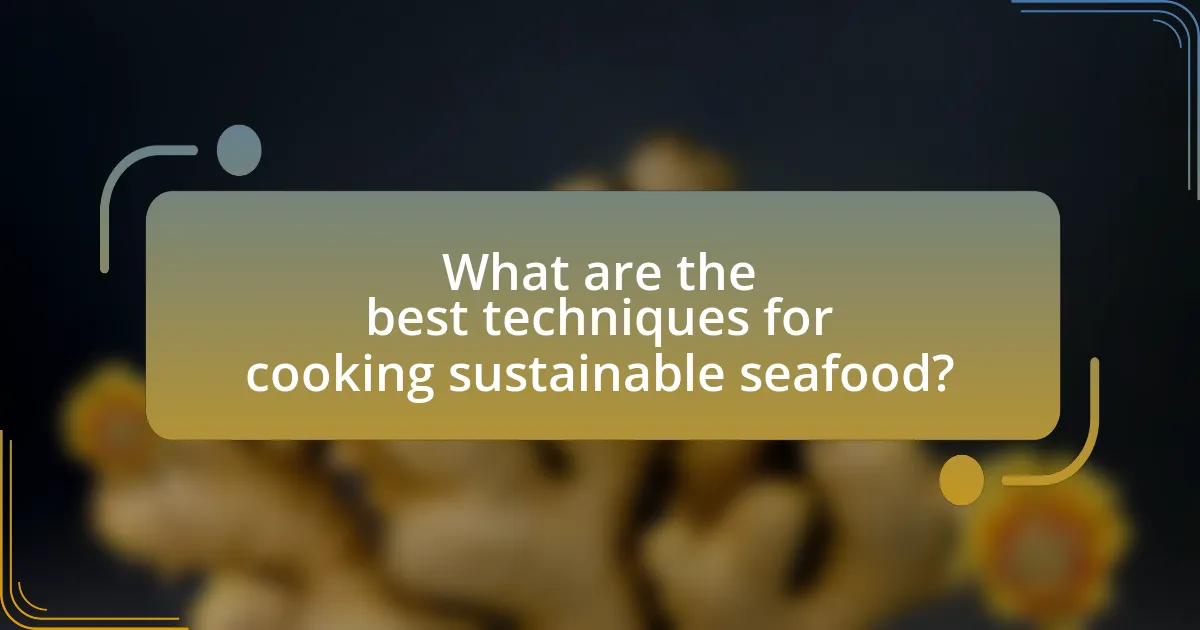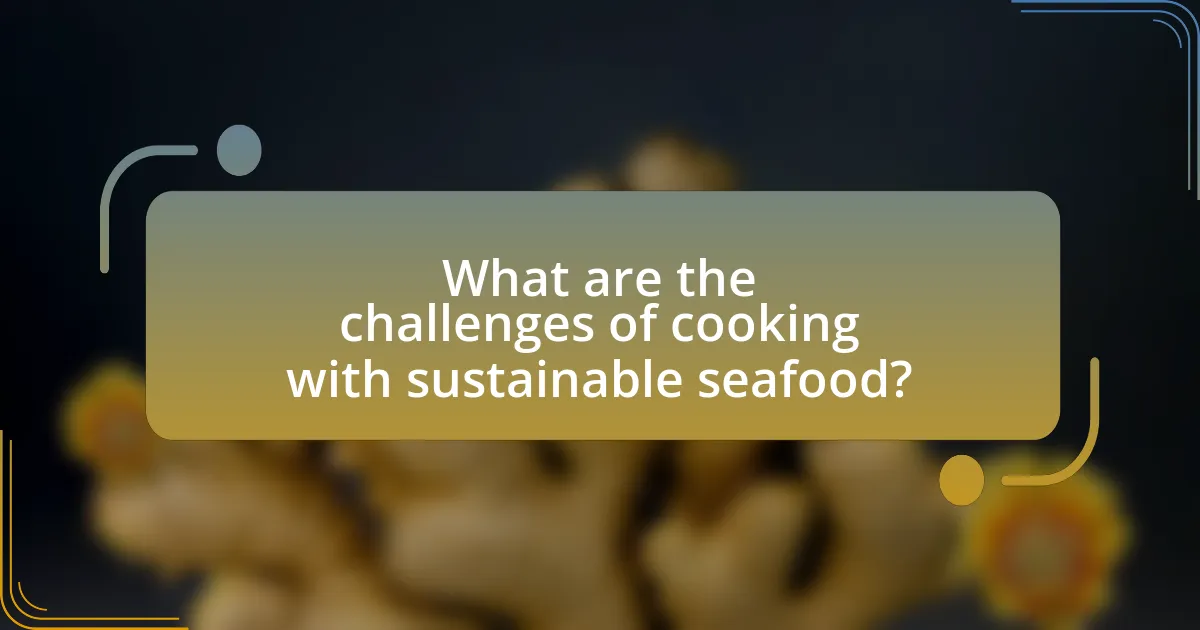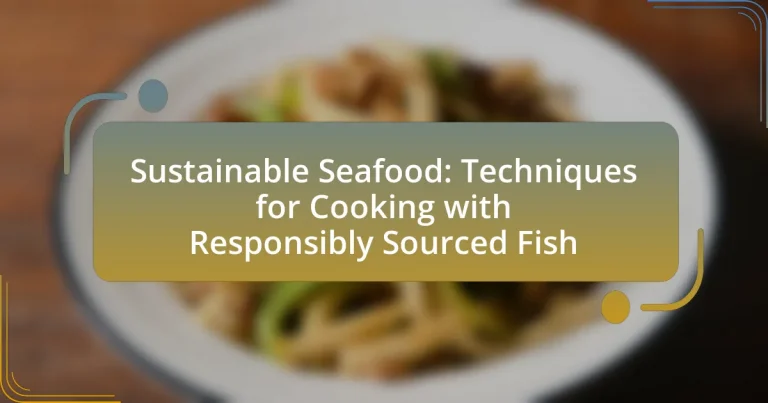Sustainable seafood refers to fish and shellfish harvested in ways that maintain or increase populations while minimizing environmental impact. This article explores the importance of sustainable seafood for marine ecosystems, the consequences of overfishing, and the definition of responsibly sourced fish. It also provides guidance on identifying certified sustainable seafood, the role of sustainable fishing in local economies, and effective cooking techniques that preserve nutritional value. Additionally, the article addresses common challenges in cooking with sustainable seafood and offers practical tips for enhancing flavor and ensuring freshness.

What is Sustainable Seafood?
Sustainable seafood refers to fish and shellfish that are harvested in ways that maintain or increase populations and minimize environmental impact. This concept encompasses practices that ensure fish stocks are not overfished, habitats are protected, and ecosystems remain healthy. According to the Marine Stewardship Council, sustainable seafood is sourced from fisheries that are well-managed and environmentally responsible, ensuring that the fishing practices do not deplete fish populations or harm the marine environment.
Why is sustainable seafood important for the environment?
Sustainable seafood is important for the environment because it helps maintain healthy fish populations and ecosystems. Overfishing and destructive fishing practices can lead to the depletion of marine species and damage to habitats, such as coral reefs. According to the Food and Agriculture Organization, approximately 34% of global fish stocks are overfished, which threatens biodiversity and the balance of marine ecosystems. By choosing sustainable seafood, consumers support fishing practices that are environmentally responsible, ensuring that fish populations can replenish and ecosystems remain intact.
How does overfishing impact marine ecosystems?
Overfishing significantly disrupts marine ecosystems by depleting fish populations and altering food webs. When fish are removed at unsustainable rates, predator-prey relationships are destabilized, leading to overpopulation of some species and decline of others. For instance, the collapse of cod stocks in the North Atlantic has resulted in an increase in smaller fish populations, which in turn affects the entire marine food chain. Additionally, overfishing can lead to habitat destruction, as fishing practices like bottom trawling damage ocean floors, further harming biodiversity. Studies indicate that overfishing has contributed to a 90% decline in large predatory fish populations since the mid-20th century, underscoring its profound impact on marine ecosystems.
What are the long-term effects of unsustainable fishing practices?
Unsustainable fishing practices lead to significant long-term effects, including the depletion of fish populations, disruption of marine ecosystems, and loss of biodiversity. Overfishing can result in the collapse of fish stocks, as evidenced by the decline of cod in the North Atlantic, where populations fell by over 90% due to excessive fishing. Additionally, unsustainable practices such as bottom trawling damage seabed habitats, affecting the entire marine food web. The loss of key species disrupts ecological balance, leading to further declines in other marine life. Furthermore, these practices can negatively impact coastal communities that rely on fishing for their livelihoods, as diminished fish stocks reduce economic opportunities.
What defines responsibly sourced fish?
Responsibly sourced fish is defined as fish that is harvested in a manner that ensures sustainability, minimizes environmental impact, and supports the livelihoods of fishing communities. This includes adherence to regulations that prevent overfishing, the use of fishing methods that reduce bycatch and habitat destruction, and certification by recognized organizations such as the Marine Stewardship Council (MSC) or the Aquaculture Stewardship Council (ASC). These certifications are based on rigorous standards that assess the health of fish populations, the ecosystem, and the socio-economic conditions of fishing communities, ensuring that the fish is sourced in a way that is ecologically responsible and socially equitable.
How can consumers identify responsibly sourced seafood?
Consumers can identify responsibly sourced seafood by looking for certifications from reputable organizations such as the Marine Stewardship Council (MSC) or the Aquaculture Stewardship Council (ASC). These certifications indicate that the seafood has been sourced sustainably, adhering to environmental and social standards. For example, the MSC label signifies that the fish comes from a fishery that is well-managed and sustainable, while the ASC label ensures that farmed seafood meets strict environmental and social criteria. Additionally, consumers can consult seafood guides from organizations like the Monterey Bay Aquarium, which provide recommendations on sustainable seafood choices based on species and sourcing practices.
What certifications should consumers look for when purchasing seafood?
Consumers should look for certifications such as the Marine Stewardship Council (MSC) and the Aquaculture Stewardship Council (ASC) when purchasing seafood. The MSC certification indicates that the seafood is sourced from sustainable fisheries that adhere to strict environmental standards, while the ASC certification ensures that farmed seafood is produced responsibly, minimizing environmental impact and promoting social responsibility. These certifications are recognized globally and provide assurance that the seafood has been harvested or farmed in a manner that supports the health of marine ecosystems and communities.
How does sustainable seafood contribute to food security?
Sustainable seafood contributes to food security by ensuring a stable supply of fish that meets the nutritional needs of populations while preserving marine ecosystems. By employing responsible fishing practices, sustainable seafood helps maintain fish populations at healthy levels, which is crucial for long-term availability. According to the Food and Agriculture Organization, sustainable fisheries can provide food for over 1 billion people globally, highlighting their role in combating hunger and malnutrition. Additionally, sustainable seafood practices support local economies and livelihoods, further enhancing community resilience and access to food resources.
What role does sustainable fishing play in local economies?
Sustainable fishing plays a crucial role in local economies by providing a reliable source of income and employment for communities dependent on fishing. It ensures the long-term viability of fish stocks, which supports local fisheries and related industries, such as processing and tourism. According to the Food and Agriculture Organization, sustainable fishing practices can lead to increased fish populations, which in turn can enhance local economic stability and food security. By maintaining healthy ecosystems, sustainable fishing also promotes biodiversity, which is essential for the resilience of local economies that rely on marine resources.
How can sustainable seafood practices support community livelihoods?
Sustainable seafood practices support community livelihoods by ensuring long-term access to fish resources, which directly benefits local economies. These practices, such as responsible fishing methods and aquaculture, help maintain fish populations and ecosystems, leading to stable income for fishermen and related industries. For example, the Marine Stewardship Council reports that certified sustainable fisheries can increase local employment opportunities and enhance food security, as communities rely on healthy fish stocks for their livelihoods. By promoting sustainable practices, communities can thrive economically while preserving marine biodiversity for future generations.

What are the best techniques for cooking sustainable seafood?
The best techniques for cooking sustainable seafood include steaming, grilling, poaching, and baking. Steaming preserves the delicate flavors and nutrients of seafood while minimizing the need for added fats. Grilling enhances the natural taste and provides a smoky flavor, making it ideal for firm fish like salmon. Poaching, which involves cooking seafood gently in water or broth, keeps it moist and tender, suitable for delicate species. Baking allows for even cooking and can incorporate healthy ingredients like vegetables and herbs, promoting a balanced meal. These methods align with sustainable practices by emphasizing healthful preparation and minimizing waste.
How can cooking methods affect the sustainability of seafood?
Cooking methods can significantly affect the sustainability of seafood by influencing energy consumption, waste generation, and the preservation of nutritional value. For instance, methods like steaming and poaching typically require less energy compared to frying or grilling, thus reducing the carbon footprint associated with cooking. Additionally, techniques that minimize waste, such as using the whole fish or incorporating by-products into other dishes, contribute to a more sustainable approach. Research indicates that sustainable cooking practices can lead to a reduction in food waste by up to 30%, which is crucial given that approximately one-third of all food produced globally is wasted. Therefore, selecting energy-efficient cooking methods and reducing waste directly enhances the sustainability of seafood consumption.
What cooking techniques preserve the nutritional value of fish?
Steaming, poaching, and baking are cooking techniques that effectively preserve the nutritional value of fish. Steaming retains moisture and nutrients by cooking the fish quickly without submerging it in water, which can leach out vitamins. Poaching involves gently cooking fish in a flavorful liquid at low temperatures, minimizing nutrient loss. Baking, particularly at lower temperatures, allows for even cooking while maintaining essential fatty acids and proteins. Research indicates that these methods help maintain omega-3 fatty acids, which are crucial for heart health, compared to frying, which can degrade these nutrients.
How do different cooking methods impact flavor and texture?
Different cooking methods significantly impact the flavor and texture of seafood. For instance, grilling enhances the natural flavors through caramelization and adds a smoky taste, while steaming preserves moisture and results in a tender texture. Sautéing allows for quick cooking, which can create a crispy exterior while keeping the inside moist. Baking, on the other hand, can lead to a firmer texture and a more concentrated flavor due to the even heat distribution. Research indicates that methods like poaching maintain delicate flavors and textures, as seen in studies on fish preparation techniques. Each method alters the chemical composition of the seafood, influencing taste and mouthfeel, thereby affecting overall culinary experience.
What are some popular recipes for responsibly sourced fish?
Popular recipes for responsibly sourced fish include grilled salmon with lemon-dill sauce, baked cod with tomatoes and olives, and fish tacos with cabbage slaw. Grilled salmon, a favorite due to its rich flavor and healthy omega-3 fatty acids, can be prepared by marinating the fish in lemon juice, olive oil, and fresh dill before grilling. Baked cod, known for its mild taste, is often combined with tomatoes and olives to enhance its flavor, providing a nutritious meal. Fish tacos, made with white fish like tilapia or mahi-mahi, are typically served with a crunchy cabbage slaw and a zesty lime crema, making them a popular choice for casual dining. These recipes not only highlight the versatility of responsibly sourced fish but also promote sustainable eating practices.
How can I prepare a simple grilled fish dish?
To prepare a simple grilled fish dish, start by selecting a fresh, responsibly sourced fish such as salmon or trout. Clean the fish and pat it dry, then season it with salt, pepper, and a drizzle of olive oil. Preheat the grill to medium-high heat and place the fish skin-side down on the grill grates. Grill for about 4-6 minutes per side, depending on the thickness of the fish, until it flakes easily with a fork. This method ensures that the fish retains moisture and flavor while being cooked evenly. Grilling fish is a popular technique that highlights the natural taste of the seafood, making it a preferred choice for many chefs and home cooks alike.
What are some creative ways to incorporate seafood into meals?
Incorporating seafood into meals can be creatively achieved through various methods such as using seafood in tacos, adding it to pasta dishes, or incorporating it into salads. For instance, fish tacos can be made by grilling or frying fish and serving it with fresh toppings like cabbage and salsa, which enhances flavor and texture. Additionally, seafood can be added to pasta dishes, such as shrimp scampi or clam linguine, providing a rich source of protein and omega-3 fatty acids. Salads can also be elevated by including grilled salmon or tuna, which not only adds nutritional value but also introduces diverse flavors. These methods not only promote the use of seafood but also align with sustainable practices by encouraging the consumption of responsibly sourced fish.

What are the challenges of cooking with sustainable seafood?
Cooking with sustainable seafood presents challenges such as limited availability, higher costs, and varying quality. Limited availability arises because sustainable seafood options depend on specific fishing practices and regulations, which can restrict supply. Higher costs are often associated with sustainable practices, as they may involve more labor-intensive methods and smaller-scale operations. Additionally, varying quality can occur due to differences in freshness and handling practices, making it difficult for cooks to achieve consistent results. These challenges necessitate careful sourcing and preparation to ensure that the seafood is both sustainable and enjoyable.
How can I overcome common cooking challenges with fish?
To overcome common cooking challenges with fish, ensure proper preparation techniques, such as using a sharp knife for filleting and removing bones, which enhances the cooking process. Additionally, marinating fish can help combat dryness and enhance flavor, as fish tends to cook quickly and can easily become overcooked. Cooking methods like poaching or steaming can also prevent fish from drying out, as these methods maintain moisture. According to the USDA, fish should be cooked to an internal temperature of 145°F to ensure safety while preserving texture and flavor.
What are the best practices for handling and storing seafood?
The best practices for handling and storing seafood include keeping it at a temperature below 40°F (4°C) to prevent bacterial growth, using ice or refrigeration immediately after purchase, and ensuring that seafood is stored in a clean, airtight container to maintain freshness. Proper handling also involves washing hands and surfaces before and after contact with seafood to avoid cross-contamination. According to the U.S. Food and Drug Administration (FDA), seafood should be consumed within two days of purchase if stored in the refrigerator, or it can be frozen for longer storage, ideally within three to six months, depending on the type of seafood.
How can I ensure my seafood is fresh before cooking?
To ensure seafood is fresh before cooking, examine its appearance, smell, and texture. Fresh seafood should have a clean, ocean-like scent, bright and clear eyes if whole, and firm flesh that springs back when pressed. Additionally, check for moist, shiny skin and vibrant color, as dullness can indicate age. According to the FDA, seafood should be kept at a temperature below 40°F to maintain freshness, and purchasing from reputable sources can further guarantee quality.
What tips can help me cook sustainable seafood effectively?
To cook sustainable seafood effectively, prioritize sourcing seafood from certified sustainable fisheries, such as those recognized by the Marine Stewardship Council. This ensures that the seafood is harvested in a way that maintains fish populations and minimizes environmental impact. Additionally, use cooking methods that enhance the natural flavors of the seafood, such as grilling, steaming, or baking, rather than frying, which can add unnecessary fats and calories.
Moreover, consider the seasonality of the seafood; for example, certain fish are more abundant during specific times of the year, which can help reduce overfishing. According to the Seafood Watch program, choosing species that are abundant and well-managed, like Pacific sardines or farmed shellfish, can further support sustainable practices. Lastly, avoid using harmful additives or excessive salt, as these can detract from the seafood’s natural taste and health benefits.
How can I enhance the flavor of responsibly sourced fish?
To enhance the flavor of responsibly sourced fish, use marinades that include acidic components like lemon juice or vinegar, along with herbs and spices. Acidic ingredients help to tenderize the fish and elevate its natural flavors, while herbs such as dill, parsley, or cilantro add freshness. For example, a marinade of olive oil, lemon juice, garlic, and fresh herbs can significantly improve the taste profile of fish. Studies show that marinating fish for at least 30 minutes can enhance flavor absorption and overall palatability.
What are some common mistakes to avoid when cooking seafood?
Common mistakes to avoid when cooking seafood include overcooking, which can lead to a rubbery texture and loss of flavor. Seafood cooks quickly, often in just a few minutes, so monitoring cooking time is essential. Another mistake is not properly thawing frozen seafood, as this can result in uneven cooking and compromised texture. Additionally, using the wrong cooking method for the type of seafood can diminish its quality; for instance, delicate fish should be pan-seared or steamed rather than grilled. Lastly, neglecting to season seafood adequately can lead to bland dishes, as seafood benefits from herbs, spices, and marinades that enhance its natural flavors.


